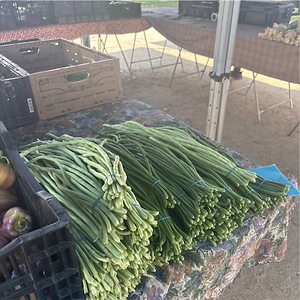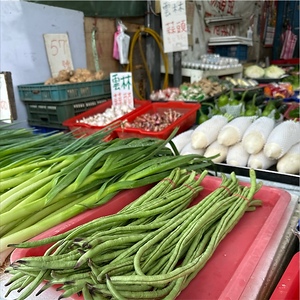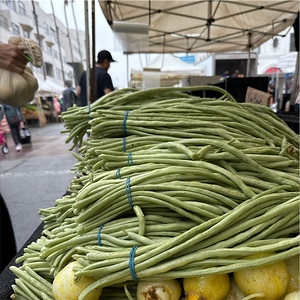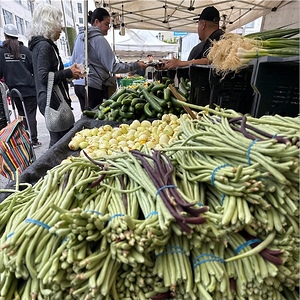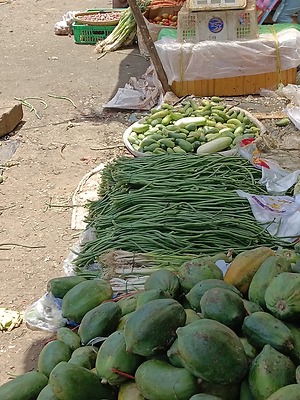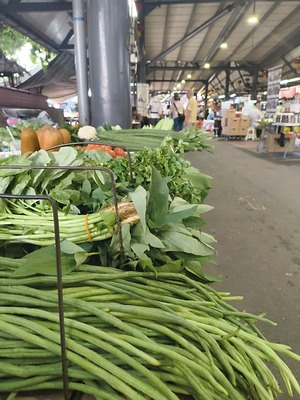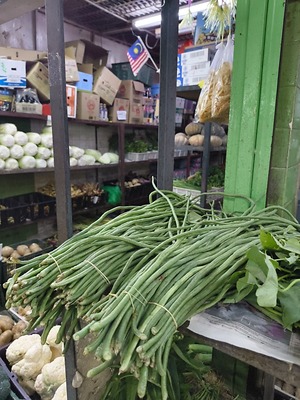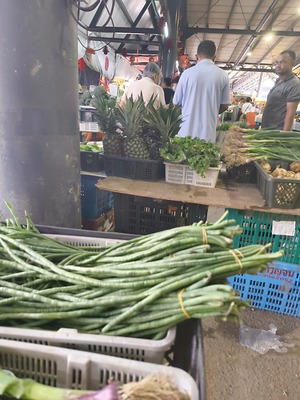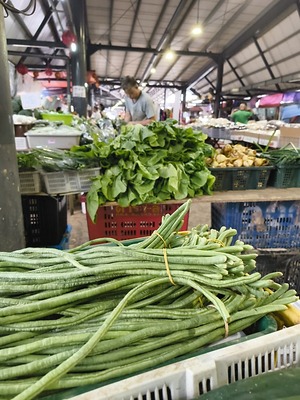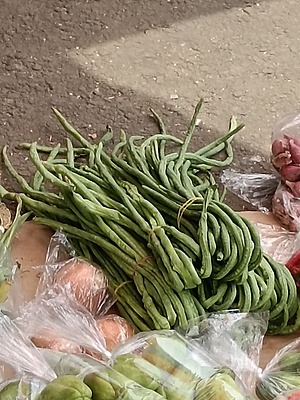

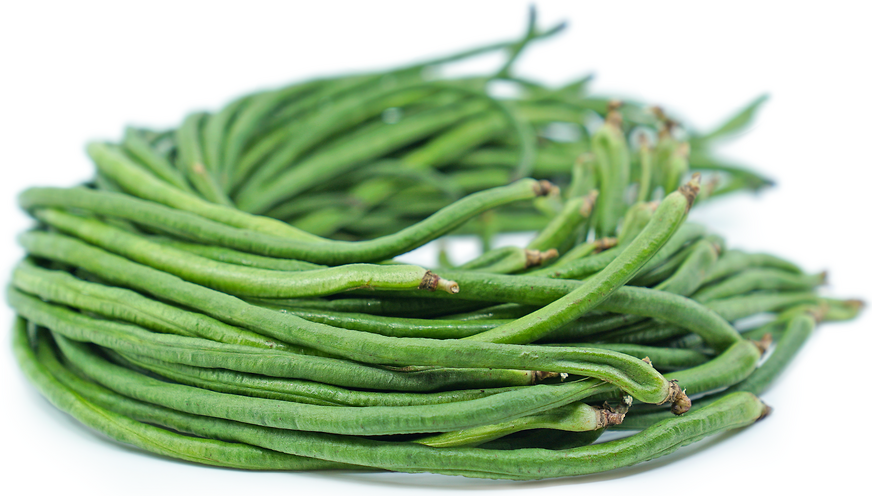
Chinese Long Beans
Estimated Inventory, 10 lbs : 4.07
This item was last sold on : 07/29/25
Description/Taste
Chinese Long beans vary in size and length, depending on age at harvest, and are preferred in their young state, averaging 30 to 76 centimeters in length. The slender, elongated pods are favored when they are narrow, about the width of a pencil, and have a cylindrical, pliable nature. Chinese Long beans feature a smooth, taut, and firm surface, sometimes covered in small textured grooves. The pods mostly appear in light and dark green shades, but other varieties are occasionally found in purple hues. The pods also bear a crisp, tender, and succulent consistency when young. Chinese Long beans snap easily when bent in half and are stringless. As they mature, the pods become tough and inedible. Inside the pods are young, tiny, kidney-shaped seeds. Most pods contain 8 to 20 seeds, and each variety differs in color, from pale green and white to black and cream. Chinese Long beans are edible raw when young and have a grassy, green, and subtly sweet taste. Once cooked, the beans develop a savory nuance and are said to sometimes contain a hint of an asparagus-like flavor.
Seasons/Availability
Chinese Long beans are available year-round, with a peak season in the summer and fall, depending on the growing region.
Current Facts
Chinese Long beans, botanically classified as Vigna unguiculata subsp. sesquipedalis, are a well-known legume belonging to the Fabaceae family. The species is a type of cowpea that forms on climbing vines extending 2 to 4 meters in length. The plants are fast-growing, producing edible pods within 40 to 70 days of sowing. Chinese Long beans grow in pairs on the vines and are a drought-tolerant species with an extended season, providing successive harvests of edible pods and leaves for culinary use. Worldwide, Chinese Long beans are known by many regional names, including Asparagus bean, Long bean, Long-Podded cowpea, Noodle bean, Yard-long bean, and Snake bean in English. In Asia, the beans are called Cháng Dòu Jiao in Chinese, Sasage in Japanese, Jul-kong in Korean, Tua fak yao in Thai, Dậu đũa in Vietnamese, Kacang Panjang in Indonesian and Malaysian, and Sitaw in Filipino. The elongated beans are typically picked when young and tender and are sold in bundles in fresh markets. The leaves are also a secondary crop gathered from plants as a spinach-like green. It is important to note that several varieties of Chinese Long beans appear in various hues, and each region will have preferences for the preferred type. Chinese Long beans are versatile and are eaten fresh or cooked in a wide array of savory culinary preparations.
Nutritional Value
Chinese Long beans are a source of fiber to aid digestion and vitamins A, B, C, and K to maintain healthy organs, assist in faster wound healing, strengthen the immune system, and contribute to energy production in the body. The legumes also contain folate to produce red blood cells and minerals like iron, magnesium, phosphorus, calcium, potassium, manganese, and copper. Iron helps the body make the protein hemoglobin for increased oxygen transport through the bloodstream, magnesium controls daily nerve functions, while phosphorus and calcium support bone and teeth development. Potassium balances fluid levels within the body, while manganese and copper assist with the formation of connective tissues. In Traditional Chinese Medicine, Long beans are believed to provide energy and are known for their anti-inflammatory and antioxidant properties.
Applications
Chinese Long beans have a fresh, grassy, savory, and subtly sweet taste suited for fresh and cooked preparations. The legumes are preferred in their young, tender, and crisp state for culinary use and should be washed and divided into smaller pieces. It is common to snap the pods instead of cutting them, as many chefs believe the pods retain a better appearance and flavor when broken by hand. Once prepped, Chinese Long beans can be blanched and served in salads. The elongated, slender pods are popularly stir-fried, braised, or simmered throughout Asia and are often added to vegetable and meat dishes. Chinese Long beans are commonly cooked with soy sauce, garlic, ginger, and chile peppers in China and Taiwan. In Thailand, India, and other Southeast Asian regions, Long beans are simmered into curries and soups. Kuah daun singkong is a well-known spicy and sour vegetable soup that often features Long beans as a savory ingredient. Outside of Asia, Chinese Long beans are used in green bean dishes and are grilled, blanched, roasted, or baked. Try adding blanched Long beans to crudité plates or using their elongated nature to make small nests to fill with meat and other ingredients. In addition to the young pods, Chinese Long beans can be matured and shelled like black-eyed peas. The leaves can also be cooked like spinach or dried and ground into a powder for extended use. Chinese Long beans pair well with meats like beef, pork, and poultry, tofu, eggs, sesame seeds, potatoes, corn, eggplant, and spices like cinnamon, bay leaves, and Sichuan peppercorns. Whole, unwashed Chinese Long beans should be used relatively quickly after purchase for the best quality and flavor and will keep for 3 to 5 days when stored in the refrigerator.
Ethnic/Cultural Info
Long beans are famously fermented into a savory, spicy culinary ingredient in the southwestern province of Sichuan in China. Fermenting, sometimes referred to as soaking in Sichuan, was historically a method to preserve abundant crop harvests for the winter season. Long beans are notoriously productive and develop many elongated pods throughout the summer and fall. After fresh harvest, the pods are wrapped into a vessel and are submerged in a mixture of chiles, spices, and liquid to ferment. Long beans are typically left to ferment for 7 to 10 days, and the longer the pods are left to soak, the more sour and tangy they will become. Once fermented, Long beans are chopped into smaller pieces and added to minced pork dishes, rice recipes, and soups. Several batches of legumes can be prepared with a mixture of liquid and spices, and the act of making fermented Long beans and then utilizing them in culinary dishes is a treasured, labor-intensive process to create signature dishes of the province.
Geography/History
Chinese Long beans are believed to be descendants of cowpea species native to tropical regions in Africa. Much of the species’ history is unknown and heavily debated. It is thought that over time, wild relatives were selected for cultivation and were spread along trade routes into the Middle East and Asia. After their introduction into Asia, sources note that new types of cowpeas were developed through domestication, eventually creating the elongated, long-podded types. Long beans were first documented in China during the Song Dynasty, around 1008 CE, and the culinary legumes expanded in cultivation commercially and in home gardens throughout Asia and Southeast Asia. Long beans were also spread to the New World in the 16th century through Portuguese sailors. The species was later planted in the Caribbean and the United States around the 18th century. Today, Chinese Long beans are grown in tropical to subtropical climates worldwide, with concentrated production in Asia and Africa. The legumes are also grown in smaller quantities in greenhouses in Europe and are expanding in cultivation throughout Florida and California. When in season, Chinese Long beans are sold fresh through local markets, select wholesalers, and directly from growers.
Featured Restaurants
Restaurants currently purchasing this product as an ingredient for their menu.
| Addison Del Mar | Del Mar CA | 858-350-7600 |
| Dija Mara | Oceanside CA | 760-231-5376 |
| Sovereign Thai Cuisine | San Diego CA | 619-887-2000 |
| Kinme Omakase | San Diego CA | 619-231-0700 |
| Animae | San Diego CA | 619-925-7908 |
| Ctzn | Solana Beach CA | 858-925-7141 |
| Hotel La Jolla - Sea & Sky | La Jolla CA | 858-459-0261 |
| The Santaluz Club Inc - Main Dining | San Diego CA | 858-759-3150 |
| La Valle Coastal Club | Rancho Santa Fe CA | 858-759-5473 |
| InterContinental Vistal Kitchen | San Diego CA | 619-501-9400 |
| Make Stuff Good | San Diego CA | 949-547-9470 |
| Le Coq | La Jolla CA | 858-427-1500 |
| Kinme (Deliver to Azuki) | San Diego CA | 619-238-4760 |
Recipe Ideas
Recipes that include Chinese Long Beans. One



